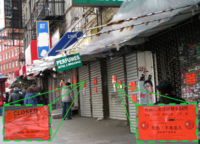EconomyFrom The Peopling of New York City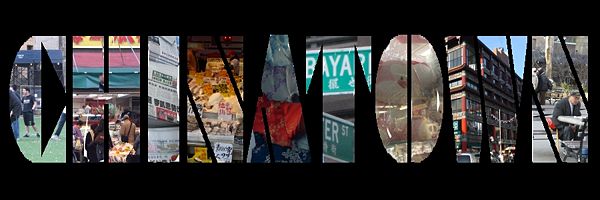
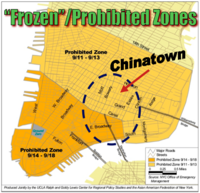 Figure 1: These are the initial street closures right after September 11th. It encompasses all of Chinatown. These zones prohibited all unauthorized vehicles from entering. Pedestrians were also not permitted to walk past these areas, except for residents of the area.[2] 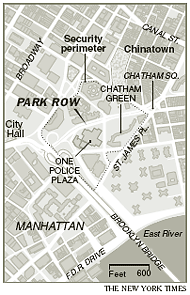 Figure 2: This shows the area that is still closed to commuter traffic due to the September 11th. Part of the reason is to protect the New York Police Department’s headquarters. Pedestrians and authorized vehicles are normally let through.[3] Not a lot of people are going to Chinatown anymore, at least not like they used to. Reporter Eric Asimov of the New York Times says, "It's not just the restaurants, although that's a pretty good place to start, but fish shops, meat markets, greengrocers and purveyors of things you never knew you wanted, like dried licorice plums, which doubtless have some health benefit but to me just smell good." New places keep popping up and places keep changing because of Chinatown's decline. The September 11th attacks as well as the SARS link to Asia really brought Chinatown's economy spiraling down, but only accelerated a situation that was already happening. WNYC radio's talk show host, Leonard Lopate, said "Life was tough there even before 9/11." He lived in Chinatown for thirty years before moving to Brooklyn in 2001.[4] There was a case study titled "Chinatown One Year After September 11th: An Economic Impact Study" that was done by the Asian American Federation of New York. For the first two weeks after September 11th the neighborhood was restricted as seen in Figure 1. Transportation was unavailable into and out of Chinatown, so businesses were at a standstill. After that initial period, some streets were still blocked off and there was increased security, as seen in Figure 2. Even though businesses started to get back to more normal routines, they still struggled. The study area is given in the Figure 3 and the percentages tell the percentage of Chinese people in the area. 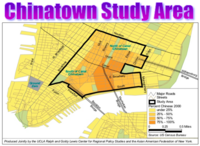 Figure 3: The area of study and percentages of Chinese people in the area.[5] The study says that the garment industry lost close to $500 million in just that year following September 11. For the summer of 2002 businesses reported an average of a 20% decline from the previous summer sales. Some businesses suffered more than others. Restaurants saw a 70% decline in business, the garment factories saw a 65% decline, and jewelry stores saw a 50% decline. This affected workers as well as many reported reduced hours or unemployment.[6] 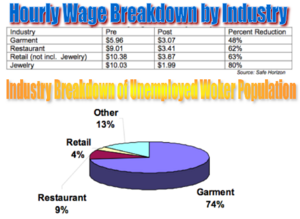 Figure 4:The impact of September 11th on businesses as well as workers.[7] Chinatown has many jewelry stores, especially along Canal Street. This started back in the 1930's when Europeans set up a diamond market on the eastern end of Canal, after fleeing from the Nazis. After World War II, many of the jewelers moved their business to Midtown making the jewelry district on 47th Street; however, in the 1970's, Chinese entrepreneurs restarted Chinatown's jewelry district. This became a great industry as many new jewelers opened shop. There have been declines in business after the September 11th attacks and due to decreased consumer spending. In 2002 jewelry merchants in Chinatown reported that business was down 30% to 50% compared the previous year. Jewelry places else where in Manhattan also reported a drop but only about 20% to 25%. This caused some shops in Chinatown to close down and be replaced by new types of stores.[8] Even today the economy in Chinatown is struggling, especially restaurants. They are not attracting enough tourists to make up for the high rents and Peter Kwong, a professor at Hunter College, said, "As a result, many Chinese restaurants are moving uptown...In Chinatown the restaurants play hardball with their workers, and the same attitude prevails in these new restaurants. They squeeze their workers real hard. And they feel they can do that because many of the workers just got off the boat." Restaurant workers have to deal with conditions such as being paid less than minimum wage, deductions in paychecks, no medical care, and loss of money from tips. Workers in the restaurants are now fighting back. Deliverymen are protesting several times a week, holding up signs and shouting their demands. Yu Guan Ke, a deliveryman for Saigon Grill, claims that he was paid only $120 for 75-hour work weeks. He and other workers have currently filed lawsuits against the owners of their respective restaurants. Restaurants aren't the only businesses in legal trouble.[9] 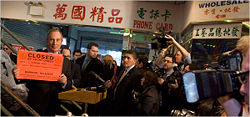 Mayor Bloomberg closing down the stores.[10] Chinatown has long been known for it's fake designer handbags, watches, perfumes, and more. Tourists as well as New Yorkers haggle for lower prices for these knockoffs in the area Mayor Bloomberg called the "Counterfeit Triangle." In a two-month undercover operation, police officers along with the mayor's Office of Special Enforcement went around the area of Canal, Walker, Baxter, and Centre Streets to catch the vendors who sell the counterfeits. By February 26th, 2008, 32 stores were closed down as over one million dollars worth of products were seized. Mayor Bloomberg approximates that the sales of these counterfeits made the city loss about one billion dollars in sales tax per year.[11] Chinatown is also opening up to a new class of New Yorkers, who had never before thought of living in Chinatown. They are doing so by constructing Luxury Condominiums. The area has long been home to the working-class immigrants in the tenement buildings. These apartments are being valued at or above $1000 per square foot and penthouse apartments have been sold for as much as $3,000,000. Perhaps this is good for the area’s real estate market, but it also brings up the fear that this will negatively affect Chinatown's immigrants, who would be driven out if prices continue to increase. William Fegan, a partner in TriBeach Holdings, which turned a garment factory building into lofts, said, “It used to be that Little Italy felt threatened by Chinatown, but now SoHo is pushing over, and Chinatown is receding and feeling threatened. The whole corridor is getting gentrified.” This can perhaps better Chinatown’s economy.[12] After good sign to Chinatown’s economy is the many banks situated throughout Chinatown. Charles Lai, executive director of the Museum of Chinese in the Americas, said "There is a waiting list for safe deposit boxes in Chinatown, and that can become Commerce Bank's competitive advantage." He said this back in 2005 when a new Commerce Bank opened at the 155 Canal Street, predicting that the bank will be not lack business. Many Chinese immigrants use cash deposit boxes because they don't want a bank statement that says how much they have and many of them share rented rooms so they don't want their valuables lying around. This has kept Chinatown’s many banks in business for decades, as HSBC first came into Chinatown over thirty years ago and now has three more branches. There is competition between the more than 30 bank branches in Chinatown, but many of them are able to prosper. This is because not only do they have local customers, but customers in other neighborhoods as well. Mr. Lai says, "Chinatown is an important economic engine for the banking industry in the city." [13] Chinatown's banks have also combined to have the highest bank-per-capita-ratio in New York City. The Asian American Federation of New York, a nonprofit organization, did a study in 2005 that said Chinatown banks total deposits exceed $5.4 billion.[14]
Economy in PicturesRestaurants
Food Markets and Grocery Stores
Canal Street
Jewelry Stores
Banks
References
|
